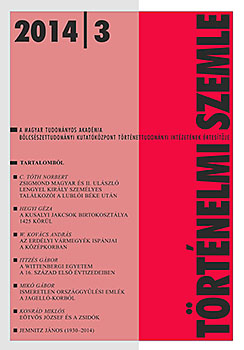A kusalyi Jakcsok birtokosztálya 1425 körül
The Estate Division of the Jakcs of Kusaly Family around
Author(s): Géza HegyiSubject(s): Law, Constitution, Jurisprudence, Economic history, Social history, Family and social welfare, 13th to 14th Centuries, 15th Century
Published by: Magyar Tudományos Akadémia Bölcsészettudományi Kutatóközpont Történettudományi Intézet
Keywords: Jakcs family; Kusaly family; Hungary; noble estates;
Summary/Abstract: The Jakcs family, which originated from the Szilágyság region, had belonged to the narrow political élite of the Hungarian kingdom between 1382 and 1441. After the middle of the 15th century, however, they definitively dropped from the ranks of the barons. During their presence in the court they had managed to build up a medium-sized landed wealth, which in 1423 consisted of one castle (Hadad [Hodod, Romania]), some 50 to 60 estates in perpetuity, and a further 30–35 by right of pledge. The majority lay around the ancient property of Kusaly (Coșeiu, Romania), in the counties of Közép-Szolnok and Kraszna, and the rest in that of Kraszna. This landed wealth was divided around 1425 between the two principal branches of the family, that is, the descendants of György I (†1415/1416) on the one hand, and those of István I († after 1418) on the other. As we have no comprehensive report about this division, the act itself can only be reconstructed by working backwards from later material after all the surviving charters of the family had been gathered, grouped and filtered. The emerging picture shows that in the case of 28 estates owned in perpetuity and 4 in pledge each settlement was divided by peasant plots, whereas the remaining ones were assigned undivided (and in roughly equal numbers) to one or the other branch. (In the wake of Pál Engel the former type is known as division by plots, while the latter as division by blocks.) The case analysed here nuances the model elaborated by Engel, according to which after 1360 division by plots became exclusively applied at the division of noble estates. It also makes evident the existence of a third type, that of mixed division, which was obviously a combination of the other two. Alongside that of the Jakcs, the division of the Bélteki in 1424 and that of the Dezsőfi of Losonc after 1405 offer examples of the mixed division. Apparently this kind of estate division was only applied in a narrow region (along the river Szamos), and even there perhaps only in the first half of the 15th century. Which among the two elements constituting this type of division was applied depended not on the time when the settlement in question was acquired, nor on the right by which it was held; nor, indeed, can any relationship be observed, at least directly, with the population numbers. On the other hand, a strong correlation exists with the ethnic-legal qualification of any given settlement, which was then strictly taken into account; namely, it appears that in all three cases listed above, the settlements of a dominantly Hungarian character were always divided by plots, while the Romanian and Ruthenian ones were allotted to either of the branches in blocks. The underlying reason may have been that the Hungarian villages were more stable, in average three times more populous than the others, and the Hungarian tenants roughly twice as profitable as the non-Hungarian villagers, and thus a more differentiated approach was needed to make division equitable.
Journal: Történelmi Szemle
- Issue Year: 2014
- Issue No: 03
- Page Range: 383-406
- Page Count: 24
- Language: Hungarian

